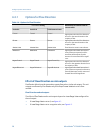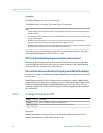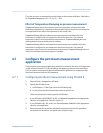
4.5.2 Configure slug flow parameters
Display
Not available
ProLink II ProLink > Configuration > Density > Slug High Limit
ProLink > Configuration > Density > Slug Low Limit
ProLink > Configuration > Density > Slug Duration
Field Communicator Configure > Manual Setup > Measurements > Density > Slug Low Limit
Configure > Manual Setup > Measurements > Density > Slug High Limit
Configure > Manual Setup > Measurements > Density > Slug Duration
Overview
The slug flow parameters control how the transmitter detects and reports two-phase flow
(gas in a liquid process or liquid in a gas process).
Procedure
1. Set Slug Low Limit to the lowest density value that is considered normal in your
process.
Values below this will cause the transmitter to perform the configured slug flow
action. Typically, this value is the lowest density value in the normal range of your
process.
Tip
Gas entrainment can cause your process density to drop temporarily. To reduce the
occurrence of slug flow alarms that are not significant to your process, set Slug Low Limit
slightly below your expected lowest process density.
You must enter Slug Low Limit in g/cm
3
, even if you configured another unit for
density measurement.
The default value for Slug Low Limit is 0.0 g/cm
3
. The range is 0.0 to 10.0 g/cm
3
.
2. Set Slug High Limit to the highest density value that is considered normal in your
process.
Values above this will cause the transmitter to perform the configured slug flow
action. Typically, this value is the highest density value in the normal range of your
process.
Tip
To reduce the occurrence of slug flow alarms that are not significant to your process, set Slug
High Limit slightly above your expected highest process density.
You must enter Slug High Limit in g/cm
3
, even if you configured another unit for
density measurement.
Configure process measurement
44 Micro Motion
®
9739 MVD Transmitters


















